Genre: Platformer Developer: Eurocom Developments Publisher: Virgin Interactive Players: 1 Released: 1995
Who would have ever thought a game designed as a soda marketing gimmick would be deemed worthy of a sequel? Yet that’s exactly what happened back in 1995 with the release of Spot Goes To Hollywood, the follow-up to the surprisingly fun (and award winning!) Cool Spot. The game’s premise revolves around Spot becoming trapped inside a movie projector. Each stage is designed around a different movie genre (action, horror, etc.) through which Spot must shoot his way. While there’s no story to speak of, the movie theme is enjoyable, and it’s fun recognizing the many film homages scattered through each stage (there’s an entire level based on TRON, of all movies). Each stage consists of three levels, which the player can tackle in any order they choose. The storyboard look of the level selection screen is a creative and attractive design which fits perfectly into the atmosphere of the game. The music is also a plus for me. Sure it’s not Castlevania or Final Fantasy, but it’s definitely above average compared to similar games and stays with you even after you’ve finished playing.
Spot Goes To Hollywood was released during the console’s twilight years and boasts some impressive pseudo-3D graphics, which remained basically unchanged even in the subsequent PlayStation and Saturn ports. Spot and his enemies are well-animated high quality sprites which don’t suffer from the hazy pixilation seen in many of the system’s shoddier titles. The environments for each level are similarly attractive (especially as you get further into the game) and are skillfully drawn with that attention to detail that helps separate platformer diamonds from the sloppy, uninspired clutter.
Alas, isometric graphics on the Genesis are a double-edged sword: aesthetically pleasing and polished on one hand yet plagued by awkward controls and distorted perspective on the other. The controls are very responsive but moving Spot around onscreen and judging distances can take some getting used to. There were times when I thought my jump was aligned perfectly only to witness Spot instead leap next to a crate, or worse, to the side of a platform and into an abyss/fiery sea of lava. These instances decrease as you get accustomed to the perspective, but even later on there are still those jumps which are frustratingly easy to misjudge. The problem can become especially apparent during boss battles, where maneuvering to execute well-timed attacks often feels more difficult than it should.
The gameplay itself doesn’t offer anything particularly innovative, but it’s still a lot of fun. Most levels have you running around shooting enemies with your infinite supply of indeterminate white projectiles, attempting to collect a certain percentage of the red spots scattered about. There are also plenty of other bric-a-brac you can collect throughout the game, although there’s really no reason for doing so, as they’re entirely useless. Despite the unchanging objectives, the levels never feel overly repetitive as each setting is unique and uses a good balance of new enemies along with familiar ones in the context of each stage. There’s also typically at least one level in each group which mixes things up, such as an underwater setting in the first stage and another in the sci-fi stage with Spot in a spaceship battling some borderline copyright infringing TIE-fighter look-alikes.
While the game seems like it would be on the short side with only four normal stages and a final boss level, you never feel cheated by the length. This is probably due to the fact that things can get rather challenging. While the first two stages don’t offer any exceptional resistance, most players will be well acquainted with the “game over” screen after spending some time in the latter two. Fortunately the password system lets you pick up where you left off. No matter how far you got in a stage though, each password lets you start with only one of your previously beaten levels still completed, so it’s important to choose wisely. There is no password to get to the final boss’s level however, which means that if you actually want to complete this game you’ll be revisiting the fourth stage quite a few times. So if your experience is anything like mine you’ll be dying an awwwwwful lot. I still have yet to beat this game, though admittedly I’m hardly in the upper echelon of the gaming elite.
Spot may be a 7up marketing shill, but when he’s in a game that’s this much fun it’s pretty hard to care. Spot Goes To Hollywood stands out as one of the more well-crafted and entertaining platformers on the Genesis, and being pretty easy to obtain for under $10, it’s well worth picking up. The game’s only downside is the somewhat awkward controls when navigating the isometric environments (though I felt Spot handled this much better than Sonic 3D Blast). While that, along with the steep difficulty of the last levels, are potential sources for frustration, they are definitely more than balanced by the overall solidness of the gameplay and polished visual presentation. A definite recommendation to any fan of the 16-bit platformer.
SCORE: 8 out of 10


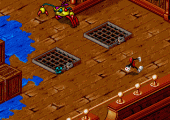
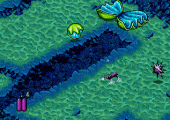
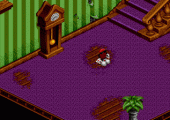
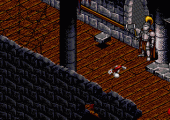
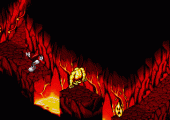
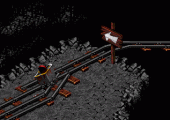
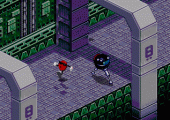
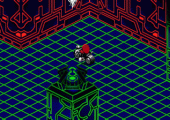
Isometric graphics has always been a bad idea, especially in a platformer. View Point, Sonic Blast, Light Crusader… Only Landstalker tackled isometric graphics correctly, but that was because your actions were somewhat limited, as it was more role playing than action. In this sequel to Dave Perry’s classic, however, the isometric view completely ruin the gameplay. Spot is very difficult to control, and most of the deaths occur because you misjudged the position of a platform or an ennemy, making the game much mor difficult than it really is. Some say that you just have to get used to it, but it’s not entirely true. Sure, by the end of the game, you won’t die as often because of the crappy gameplay. But you never feel you are in control, and for me this is the worst that can happen in a platformer. If you add to this that the game is a bit short, not very original, with disappointing music and average graphics, you end up with a mediocre sequel not worthy of the original.